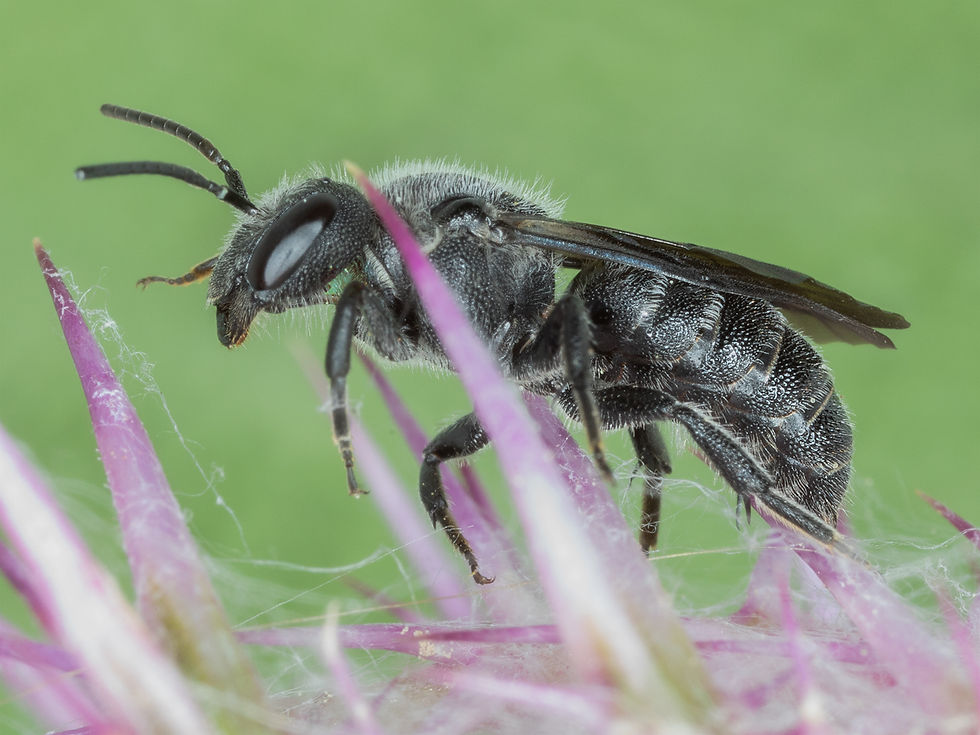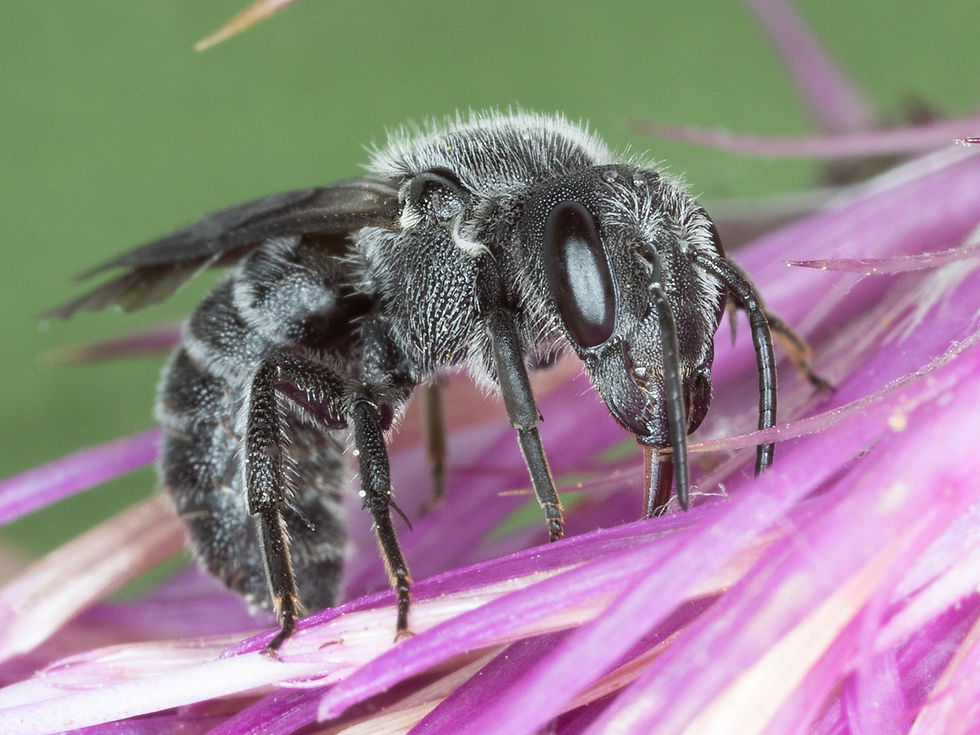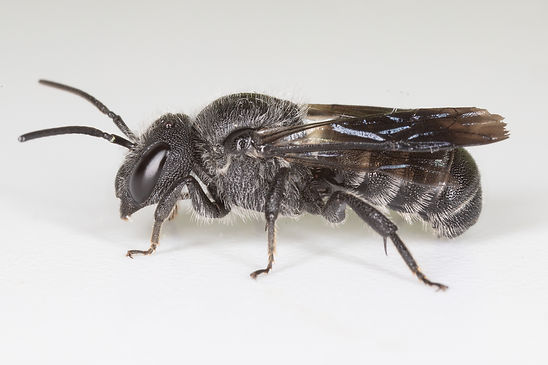SHARP-EATMAN
NATURE
PHOTOGRAPHY
FLORIDA BEES
IDENTIFICATION PAGE # F4
March 2024
Stelis ater
from Gainesville
and Aurentia
IIDENTIFIED as S. ater on I-Naturalist,
and as S. diversicolor by John L. Neff
Size: 9.5 mm
Food plants:
Yellow thistle
(Cirsium horridulum)
When and where seen:
March 20, 2024
Gainesville FL
Alachua County
Stelis ater / diversicolor
FEMALE ONE

These photos are all of the same female bee.

The bee is all black, with black wings. Its head, thorax and abdomen (terga and sternum) are coarsely pitted.




White hairs cover the bee's face. The mandibles have three teeth.

Alternate view of face.

Alternate view, showing how long the face is.

Close-up of face & tongue


Sparse white hairs appear on the thorax. The tegulae have some sparse pits, but are mostly smooth and shiny.

Dorsal view of thorax and vertex. Most of the pits on the scutum do not touch one another.

Female Stelis ater (Click to enlarge photo)

Female Stelis ater (Click to enlarge photo)

Female Stelis ater (Click to enlarge photo)
A few introductory comment on the endemic Florida species Stelis ater: There is some lingering controversy about whether Stelis ater and S. diversicolor are different species. And there is contradictory information about whether Stelis diversicolor -- the only other all-black Stelis of the U.S.--- -- is found in Florida. It is notable that the Discover Life database records that S. diversicolor has been documented at least once, in an unspecified location of Florida. Gainesville is the stomping ground of Stelis ater's discovery.
The Discover Life Stelis key, citing Mitchell, notes that Stelis ater and S. diversicolor might be separated by two traits. (1) S. diversicolor tends to run smaller (c. 8 mm) than S. ater (c. 10 mm). (2) On S. diversicolor, fewer than 50 % of the pits on the scutum touch each other. By contrast, on S. ater, more than 50% of the pits on the scutum touch each other. The male S. ater has never been formally described. The University of Florida bee key has some excellent photos, however, of dead specimens of both genders. (https://entnemdept.ufl.edu/hallg/melitto/floridabees/stelis.htm). That key does not include Stelis diversicolor as a native Florida species.
Below are four black Stelis -- three females and a male. None of the females precisely fits Mitchell's description of the species. The first female measures 9.5 mm, but the other two are larger -- 12 and 13 mm -- and seem far out of the size range of a typical Stelis diversicolor. Nonetheless, all three female bees seem to lack the character that Mitchell used to distinguish Stelis ater from Stelis diversicolor: the scutum of each is not particularly densely pitted. The male, by contrast, has a densely-pitted scutum. All four bees are from Gainesville, except for the largest female, which is from much farther to the southeast (Brevard County). All were feeding on yellow thistle (Cirsium horridulum), except for the large Brevard Co. female, which was found on Nuttall's thistle (Cirsium nuttalli). In all four cases Osmia chalybea was found within a few yards of the Stelis.
All four bees have these characteristics: they are all black bees, with dark, black-veined wings. Each has a long face, with three-toothed mandibles. Much of each bee's body is coarsely pitted (vertex, thorax, tergum, sternum). White hairs cover parts of the face, vertex and thorax). The hairs on the vertex are all light and very sparse. The females' abdomens are banded with sparse white hairs on T1, T2 and T3. On the females, T4 has white hairs laterally. Sparse white hairs also band the sternum. On the male, T1-T4 are banded with spare white hairs, and T5 has white hairs laterally.
Osmia chalybea, the documented host of Stelis ater (Rozen 2014) was found within a few yards of all four Stelis. Available literature on Stelis ater associates it exclusively with thistles.
In Texas, as in Florida, Osmia chalybea is common wherever thistles abound. Stelis diversicolor visits thistles and a range of other flora. The host of Stelis diversicolor has never been established. But, on the other hand, Osmia chalybea has never been ruled out as the host of Stelis diversicolor. Other promineent Texas Osmia include O. texana and several O. (Dicertosmia). The known hosts of Osmia (Diceratosmia) do not include Stelis diversicolor.
About size: Although Mitchell estimated the size range of Stelis diversicolor to be around 8 mm, there are specimens as large as 10 mm in Texas collections. They may well run larger - - a concerted effort to determine their size range might produce larger specimens.
Size: 9 mm
Food plants:
Yellow thistle
(Cirsium horridulum)
When and where seen:
March 25, 2024
Gainesville FL
Alachua County
Stelis ater / diversicolor
MALE

A male black Stelis, found feeding on Cisium horridulum in March in Gainesville Florida

Face of male bee: like the female, the male has a long face and three-toothed mandibles.

Lateral view of bee

Profile close-up of protuberant clypeus of male bee

Alternate view of face, showing antennae

Close-up of antenna

Dorsal view of bee, showing vertex, scutum and scutellum

Close-up of pits on vertex, scutellum and scutum. In comparison with female dark stelis #1 shown above, a large percentage of the pits on the scutum of this male bee touch one another.

Lateral view of abdomen

Alternate lateral view

Rear view of abdomen

Rear view of abdomen

Male Stelis (Click to enlarge photo)

Male Stelis (Click to enlarge photo)
Size: 12 mm
Food plants:
Yellow thistle
(Cirsium horridulum)
When and where seen:
March 24, 2024
Gainesville FL
Alachua County
Stelis ater / diversicolor
FEMALE TWO

This is a female black Stelis found in the same location as the male shown above.

Alternate view of bee

This female Stelis is much larger than the female Stelis #1 shown at the top of this page.

This female measures about 11.5 mm,

Face of (this) female Stelis #2

Like the male above, this female has a protuberant clypeus.

Alternate view of face

Alternate view of face

Additional view, showing close-up of clypeus

View of thorax and vertex of bee

Dorsal view of vertex, scutum and scutellum

Additional view of vertex, scutum and scutellum

Female Stelis ater (Click to enlarge photo)

Female Stelis ater (Click to enlarge photo)
Size: 13 mm
Food plants:
Nuttall's thistle
(Cirsium nuttallii)
When and where seen:
March 24, 2024
Aurentia, Florida
Brevard County
Stelis ater / diversicolor
FEMALE THREE

A black Stelis female from Aurantia (Brevard County)

This is a large Stelis, measuring 13 mm

Face of female bee

Profile of face, showing protruding clypeus

Antenna

Mesipisternum

Dorsal view showing pits on vertex, scutum and scutellum

Additional view of vertex and thorax

Lateral view of abdomen

Rear view of abdomen

Hind leg

Middle leg

Female Stelis (Click to enlarge photo)

Female Stelis (Click to enlarge photo)